#amphibious vehicle market
Explore tagged Tumblr posts
Text
Global Amphibious Vehicle Market Report
The worldwide Amphibious Vehicle market may be divided into two segments based on End User: defense and commercial. During the anticipated period, the commercial category is expected to increase the most. The market is likely to benefit from the increasing use of amphibious excavators for dredging. In terms of both value and volume, the military sector has held the highest market share. Rising defense spending has a beneficial impact on the market.
Market for Amphibious Vehicles by Propulsion Type:
The global amphibious vehicle market report is divided into screw propellers, water jets, and track-based vehicles, among others. In terms of both value and volume, the track-based propeller sector has the biggest market share. The segment's growth is driven positively by its ability to move at high speeds on both land and water surfaces. The segment's growth will be driven by increased demand for track-based propulsion in defense applications. The amphibious vehicles enable military soldiers to survey and monitor both sea and land borders efficiently.
#Amphibious Vehicle Market#Amphibious Vehicle Market Forecast#Amphibious Vehicle Market Report#Amphibious Vehicle Market Size
0 notes
Text
#amphibious vehicle market#amphibious vehicle market size#amphibious vehicle market forecast#amphibious vehicle market report
0 notes
Text
Court Circular | 30th March 2023
Hotel Adlon Kempinski Berlin
The King and The Queen Consort, accompanied by His Majesty’s Ambassador to the Federal Republic of Germany (Her Excellency Mrs Jill Gallard) and Ms Franziska Giffey (Governing Mayor of Berlin), this morning signed the City’s Golden Book before His Majesty called upon Mr Olaf Scholz (Federal Chancellor of the Federal Republic of Germany) at the Federal Chancellery, Berlin. The King and The Queen Consort afterwards visited Wittenbergplatz Market and were received by the Managing Director of Berlin-Brandenburg Farmers’ Market (Ms Silvia Hintsche). Their Majesties subsequently attended a Plenary Session at the Bundestag and were received by the President of the Bundestag (Ms Bärbel Bas). Ms Bas welcomed The King and The Queen Consort and His Majesty addressed the Session. The King this afternoon visited the Ukraine Arrivals Centre, Tegel Refugee Centre, Berlin, and was received by The President of the Federal Republic of Germany. His Majesty afterwards visited Wasserstrassen und Schifffahrtsamt, Finowfurt, and was received by the Minister President of Brandenburg (Dr Dietmar Woidke). The King, accompanied by the Federal President of Germany, viewed a static display of a British amphibious bridge and a mechanised infantry vehicle before viewing the completion of the amphibious bridge. His Majesty walked on to the bridge and spoke to a group of British and German soldiers. The King later visited Brodowin Organic Farm, Ökodorf Brodowin, Weissensee, Chorin, and was received by Mr and Ms Ludolf von Maltzan (Owners). His Majesty toured the dairy and viewed the ripening rooms before meeting members of the farm staff and young farmers. The Queen Consort, accompanied by Ms Büdenbender (wife of The President of the Federal Republic of Germany), this afternoon visited Refugio Café, Berlin. Her Majesty and Ms Büdenbender afterwards visited Komische Oper, Berlin.
St James’s Palace
The Princess Royal, Patron, the Injured Jockeys Fund, this morning opened their South West Hub at Taunton Rugby Club, Veritas Park, Hyde Lane, Taunton, and, having been received by His Majesty’s Lord-Lieutenant of Somerset (Mr Mohammed Saddiq), this afternoon attended a Reception at Taunton Racecourse. Her Royal Highness later opened Weston College’s Health and Active Living Skills Centre, Loxton Road, Weston-super-Mare, Somerset.
Kensington Palace
The Duke and Duchess of Gloucester this morning attended the Lord Mayor’s Big Curry Lunch Reception at Guildhall, Gresham Street, London EC2.
St James’s Palace
The Duke of Kent, Patron, the Society for Army Historical Research, this morning received Major General Ashley Truluck (Chairman) and Members of the Society’s Council and was presented with the Fellowship of the Society.
#court circular#princess anne#princess royal#king charles iii#queen camilla#prince richard duke of gloucester#birgitte duchess of gloucester#prince edward duke of kent#british royal family
15 notes
·
View notes
Text
“Atlantis Awakes”

Season 7, Episode 23 First US Airdate: December 4, 1993
Bebop is declared the King of Atlantis and the Turtles must help a half-man, half-fish to claim his rightful throne.
We’re into the final five episodes of Teenage Mutant Ninja Turtles season seven. “Atlantis Awakes” is credited to David Wise and first aired in a double bill with "Dirk Savage: Mutant Hunter".





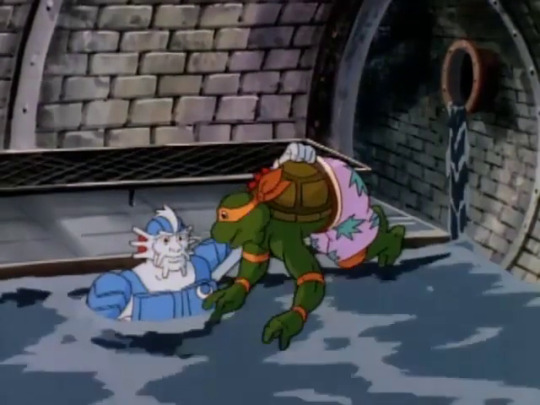
It’s rare to see the Turtles using a vehicle other than their van these days, with even the blimp popping up only occasionally. Today’s show is an exception, with one of the sewer tubes and a new dinghy carrying our heroes around underground. Michaelangelo is on a surfboard and breaks off from the team to travel down a winding tunnel, but winds up losing his footing. He narrowly avoids going over a steep drop when a mysterious figure emerges from the water to save him.




Michaelangelo’s rescuer is a half-man, half-fish called Alim Coelacanth. Providing him with a snappier (and more marketable) name, an astonished Mikey dubs him “Merdude” before reuniting with the other Turtles. The rest of the team find this talk of a fish-man dubious, but Alim emerges from the water to greet them, explaining that he’s from the city of Atlantis. Regular Turtlethon readers will know that the green teens encountered the sunken city first-hand during a visit to Greece in “The Lost Queen of Atlantis”, an episode that aired in the US mere weeks prior to the broadcast of this one. The Turtles seemingly have no memory of such an adventure now, with Raphael dismissing Atlantis as “just a myth”. Apparently either David Wise was unaware of the existence of that episode, or considered its events to be non-canon, which itself is perhaps the best possible indicator that the entire “Vacation in Europe” side-season exists outside of the proper TMNT timeline.



Alim explains to the Turtles that the other Atlanteans are human, with him being the exception; he left the city over 200 years ago in search of others of his own species. This quest has proved unsuccessful, and so he seeks to return to Atlantis, but has lost track of it. The Turtles agree to help Alim return home, and the group swim off together in search of the city.
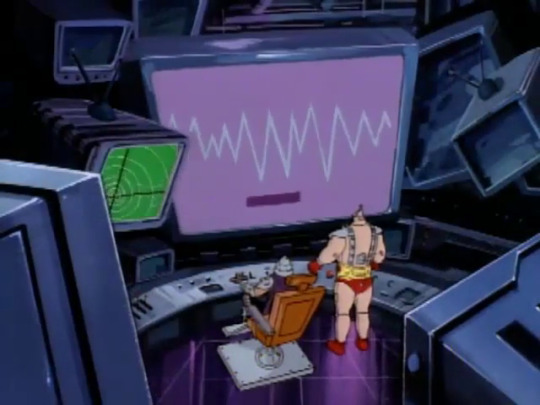


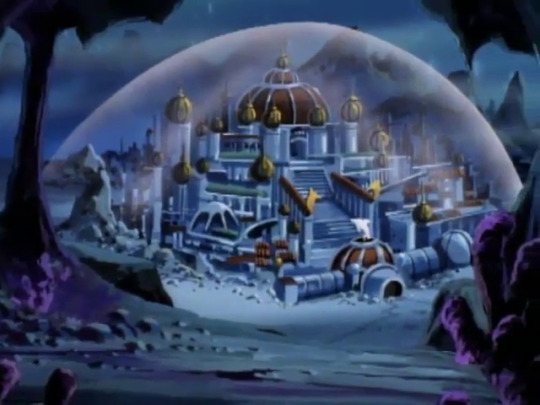

The Technodrome is rolling around at the bottom of the sea, and Krang has discovered interesting energy readings from a location nearby. Rather than driving the fortress there, Shredder leaves on a scouting mission with Rocksteady and Bebop in an amphibious transport module. The villains are stunned to discover the lost city of Atlantis under a giant dome, and demand to be granted entry. Once inside, the citizens begin bowing upon seeing Bebop, declaring that their “king has come”.
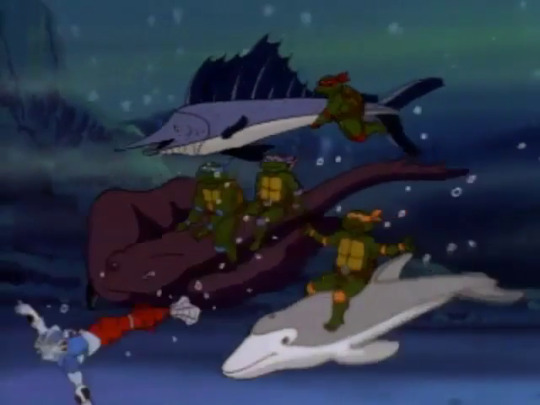
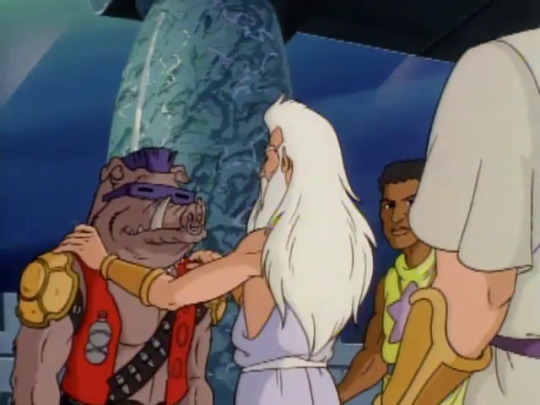

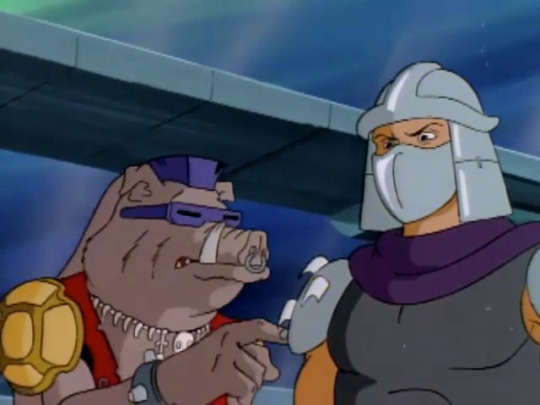


As Alim summons a group of sea creatures for the Turtles to ride so they can keep up with him, the people of Atlantis explain that they’ve waited for generations for the prophecy of a beast man to emerge who will be declared their ruler, and so Bebop is now made their king. Rocksteady is upset at this, wondering why his friend was selected for the role over him. Giving orders doesn’t come easily to Bebop, and so he leans on Shredder for advice as a dissenter called Hepax Lagamina declares this to be a farce; at the suggestion of Shreds, the new king has her dragged away to be clapped in irons.





The Turtles and Alim take an underground passage into the city, emerging in the throne room as Bebop is made king in an official ceremony. A group of spear-wielding men encircle the group as the first act ends.

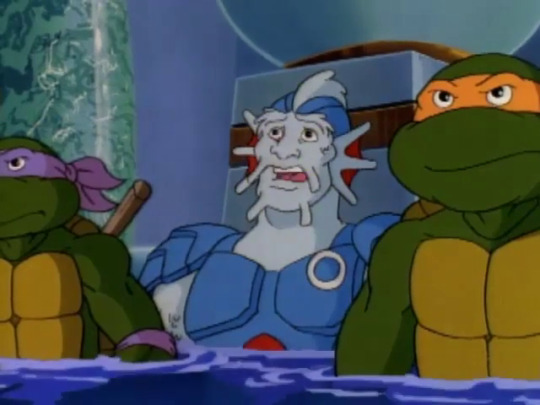


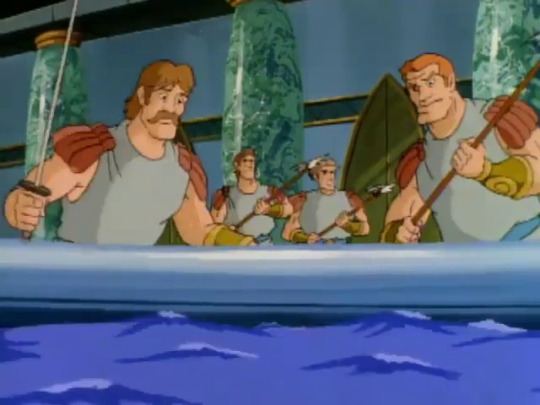


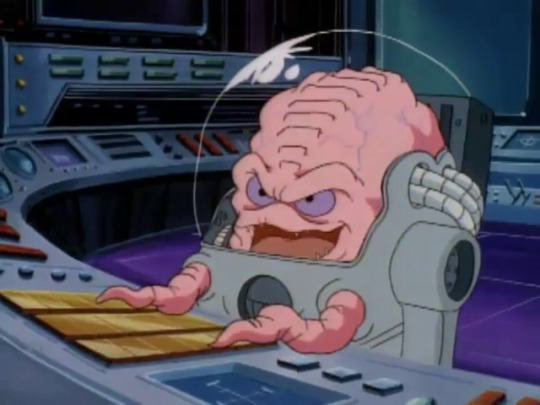
Act two opens with our heroes attempting to point out that Bebop is no king, before ultimately being forced to retreat into the water; with no breathing equipment, the Atlanteans are unable to pursue them. Later, Rocksteady complains about being passed over for the role of king to a disinterested Shredder as the two discover a room containing a giant jewel. Shredder informs Krang of this discovery, and he suggests it could be used to supercharge the Technodrome’s main cannon. Though the jewel is too heavy for Shredder and Rocksteady to carry on their own, Bebop’s influence will allow them to have the Atlanteans move it instead.







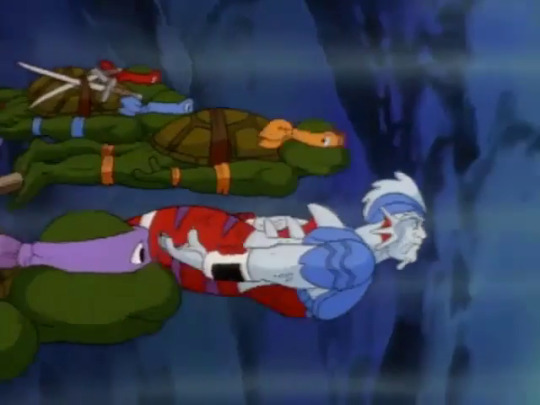
Power is beginning to go to Bebop’s head by the time Shredder returns to address him, and it doesn’t take long before the new king turns his troops against his old boss. Meanwhile Alim explains to the Turtles that the advanced equipment kept in the palace is used to power the Hammer of Atlantis. Before he can expand on its purpose, the group are distracted by cries from a voice nearby. The group find Hepax Lagamina trapped in a jail cell. Upon seeing Alim, she declares that he must be the true beast man the prophecy spoke of, and that he must challenge Bebop for the title in the Atlantean Arena. Before they can break her out, a group of guards approach, and so the Turtles and Alim are forced to escape into the water once more. This time the guards have breathing equipment, and pursue the intruders underwater.






King Bebop has Shredder get down on his knees in deference to him, alongside a now-weeping Rocksteady, who seems to be developing an inferiority complex as he watches his old buddy throw his weight around. Shreds eventually decides he’s had enough. Calling Krang via com-link, he orders that the contents of the former henchman’s room be burned. Bebop is aghast at the thought of his action figures, bubblegum cards and comic books being destroyed. He agrees to carry out Shredder’s mission, and has his troops begin the process of transporting the oversized jewel.




The Turtles battle the royal guards in the waters outside of the city, but find the odds against them. Alim uses his special powers to turn things around, calling on a group of nearby sea creatures to restrain the men. With their path now clear, our heroes head back inside.

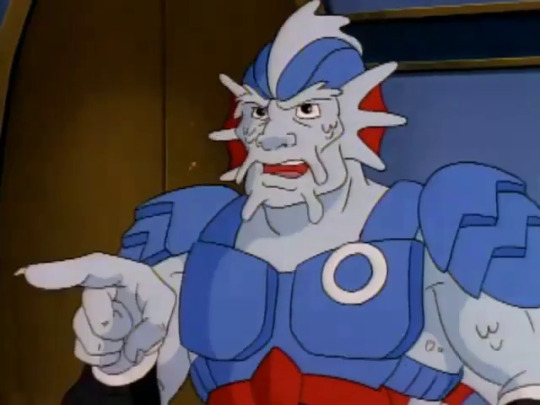


Emerging inside the palace, Donnie and Raph split off to confront Shredder, while Leo and Mikey are tasked with freeing Hepax. Alim heads to the throne room, where he confronts Bebop; The King’s advisor Malathor informs him that he must accept this challenge, or he will have to forfeit his crown.






As Leonardo and Michaelangelo battle Rocksteady for control of the keys to Hepax’s cell, Alim and Bebop begin doing battle in the arena. Shredder is confronted by Raphael and Donatello, but uses a laser blaster to bring the roof down upon the Turtles, leaving them in a pile of rubble as act two ends.







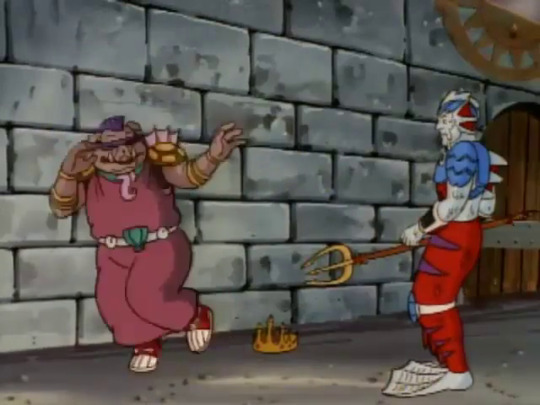


It turns out that Raph and Donnie just happened to be standing near a canal outlet while being fired upon, and were able to dip into it to avoid the impact. Though the two are unharmed, they emerge to find Shredder has escaped with the crystal. Elsewhere, Leonardo and Michaelangelo outsmart Rocksteady, trapping him in a neighbouring cell as they free Hepax. The trio head to the arena and offer words of encouragement to Alim: Hepax instructs him to grab the Trident of Power, a weapon mounted nearby, which will only be of use to the true King of Atlantis. He uses the Trident to force Bebop to admit his rule is illegitimate, leading to cheers from the city dwellers. Before Alim can celebrate, Raphael and Donatello arrive to inform him of Shredder’s theft of the jewel, which Hepax explains is the “Star of Atlantis”.








Bebop finds Rocksteady and frees him from his jail cell before tracking down Shredder and asking for his old job back. Shreds has his former henchman get down on his knees and grovel, but soon has bigger issues to deal with, as the Turtles arrive to confront him, accompanied by Alim and Hepax. As a going-away gift, he punctures the protective dome of the city with a blast from his laser weapon before escaping in his module. Alim again uses his psychic powers, this time summoning a giant squid that covers the hole and prevents any further water from getting in.


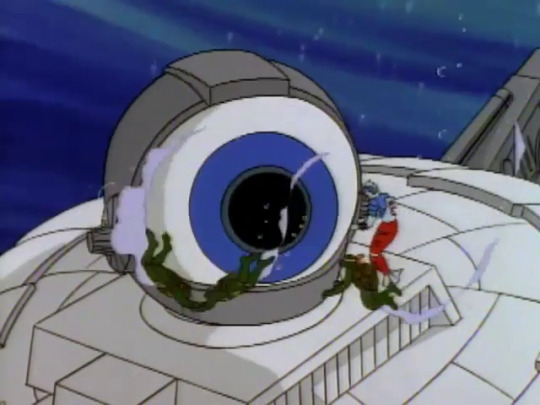


The Turtles ride a pair of whales as they follow Alim out of the city, preparing for their next move. Meanwhile Shredder’s module arrives at the Technodrome and a group of Foot Soldiers unload the Star of Atlantis. As our heroes approach Krang’s fortress, it dawns upon them that he’s about to use the crystal’s power to open fire upon Atlantis. The group push the eyeball atop the Technodrome out of alignment, leading the blast to miss its target; after retrieving the jewel, our heroes and a group of sea creatures summoned by Alim safely transport it back to the city.
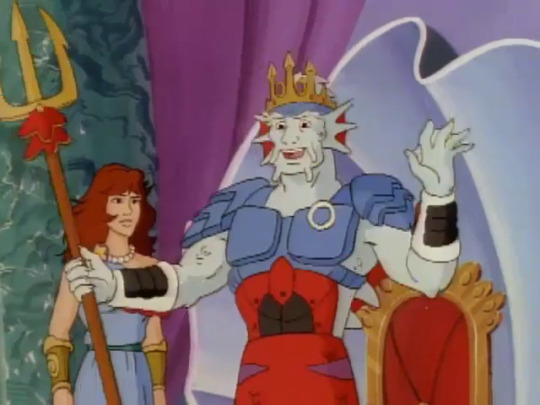


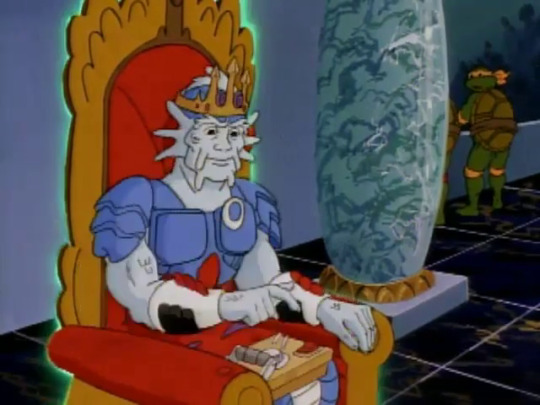

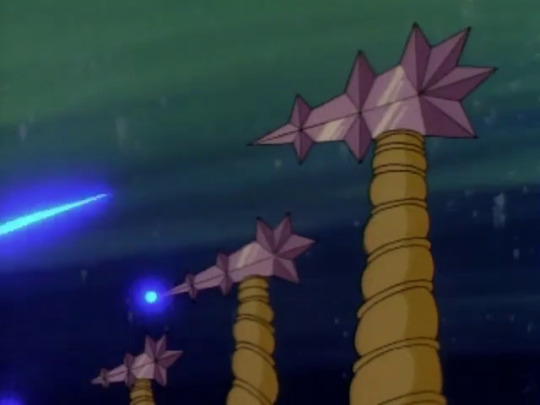

Back in Atlantis, Alim is officially declared king, and announces that Hepax will be his royal councillor. The Turtles are unconvinced by his subsequent speech about this being the start of a new, peaceful era for the Atlanteans, given that Shredder and Krang remain nearby, and their fears turn out to be well-founded: as they speak, the Technodrome is approaching the domed city and about to launch an attack. Alim is unconcerned, as the power of the Hammer of Atlantis is revealed, the large crystal being the energy source for an array of hidden weapons surrounding the city which emerge to open fire on the Technodrome. Shredder and Krang watch as their systems overload, and are forced to make a humiliating retreat.






With the day saved, Alim makes special arrangements to take our heroes home, introducing them to a quartet of giant sea turtles. Upon arriving back in the Lair, Leonardo remarks that the team has had a lot of adventures, “but this one tops ‘em all”. Michaelangelo emerges with a pizza made in Alim’s honour, the “Merdude Special”, covered in seaweed and other maritime items that leave the other Turtles queasy. The “disgusting pizza” ending, once such a fixture in the series that it was getting tiresome, has largely been taken out of rotation at this point; It’s almost nostalgic to see it dusted off for one more go-around.
I mentioned at the outset of this entry that we seldom see the Turtles use a vehicle other than their van these days; new characters popping up to coincide with their introductions to the toy line is also something that doesn’t happen as much as it did in seasons one through five. Alim / Merdude is an exception, having had a toy released a year prior to the broadcast of this adventure. My hunch is that Playmates largely didn’t care about the specifics of what went on in the cartoon by now as its drawing power had long since diminished. Moving forward, the toy line will move away from introducing new characters anyway, instead focusing on different versions of the Turtles (and occasionally Bebop and Rocksteady) with a never-ending array of bizarre gimmicks. This leaves Alim as one of the last members of an old tradition, the Mutant Guest Star of the Week: another of the many half-human, half-animal buddies that the Turtles cosy up to for twenty-two minutes, talk about maybe seeing again one day at the conclusion of the story, and then never speak of again.
Following on from “The Legend of Koji” a few weeks back, this is only the second episode ever to not feature April in any capacity. That story at least allowed Renae Jacobs to take on a different role as one of Shredder’s hired maidens, but here she’s not present at all. April’s absence is understandable as structurally it’d be tough to work her in. There’s very little wiggle room in this adventure, which kicks things off with the introduction of Alim staggeringly quickly; the fact that this is one of only a few of the Saturday morning TMNT episodes to use the shorter thirty second opening title sequence rather than the standard one-minute version is another tell-tale sign of the production team struggling to fit everything into the allocated broadcast time.
We can’t leave this adventure without returning to the thorny issue of this being the second Atlantis TMNT episode to air (for US viewers) in the space of seven weeks. But which is better? It’s no contest really: “The Lost Queen of Atlantis” had some fun stuff going on with the Turtles taking on the Atlantean cult, but it was hampered by the same ropey production values and general mediocrity that the entire Vacation in Europe side-season suffered from. It irks me to no end every time the Turtles speak as if they have no memory of prior adventures, but when it comes down to it an episode with adequate time and money spent on it like this one, from the main writer of the show, will always take precedence over what was effectively a single filler story from an entire side-season that accomplished nothing.
Next time, we’ll see the Punk Frogs and Mondo Gecko return for their final appearances in “Dirk Savage: Mutant Hunter”. PLUS: The belated TV debuts of Tokka and Rahzar!
#Teenage Mutant Ninja Turtles#TMNT#TMNT 1987#1993#Atlantis Awakes#Alim Coelacanth#Merdude#Hepax Lagamina#Ninja Turtles#Turtlethon
4 notes
·
View notes
Text

This is the 1961 Studebaker Responder, an amphibious fire response vehicle built as a part of a government bailout to keep Studebaker from filing bankruptcy. Studebaker modified the 1960 Champ heavily into an amphibious firefighter, to be sold to the forestry service. However, despite 500 being ordered, this was not enough to save Studebaker, and the company folded in 1964. Because of the nature of the vehicles, AMC was contracted to retrofit and upgrade the vehicles until 1978, when they had reached an end-of-life phase, and were sold off to the civilian market. Most were converted into hunting blinds, or were used as parade vehicles, but this one (on display at the North American Museum of Automotive Heritage in Lancaster, New York), is Serial Number 0012, remains as the earliest unmolested model currently on display. Serial Number 0004, another unmodified unit, was severely damaged in a forest fire in the California forest fires of 2020, though is currently under restoration using the remains of Serial Number 0362.
2 notes
·
View notes
Text
0 notes
Text
Military Vehicle Sustainment Market Report 2024–2032: Trends, Size, and Future Insights

Military Vehicle Sustainment Market Report 2024–2032: Trends, Size, and Future Insights
Introduction
The global Military Vehicle Sustainment Market is witnessing significant growth, fueled by advancements in defense technologies and increasing investments in maintaining and upgrading military vehicles worldwide. According to Straits Research, the market was valued at USD 22.2 billion in 2023 and is projected to grow from USD 23.9 billion in 2024 to USD 43.4 billion by 2032, registering a CAGR of 7.7% during the forecast period (2024–2032).
Download Free Sample Report: https://straitsresearch.com/report/military-vehicle-sustainment-market/request-sample
Military Vehicle Sustainment Market: Definition and Dimensions
Military vehicle sustainment refers to the continuous maintenance, repair, upgrades, and logistical support required to ensure military vehicles remain operational and effective during their lifecycle. This encompasses various services such as Maintenance, Repair, and Overhaul (MRO), spare parts supply, and modernization efforts.
Key Industry Dimensions:
Market Value (2023): USD 22.2 billion
Forecasted Market Value (2032): USD 43.4 billion
CAGR: 7.7% (2024–2032)
Key Trends in the Military Vehicle Sustainment Market
Growing investments in modernization and technological upgrades for military vehicles.
Increased focus on extending the operational lifecycle of aging military fleets.
Rising demand for advanced MRO services and innovative training solutions.
Integration of Artificial Intelligence (AI) and predictive maintenance tools.
Strategic collaborations between governments and private contractors.
Military Vehicle Sustainment Market Size and Share
The Military Vehicle Sustainment Market is a dynamic segment within the global defense industry. Driven by geopolitical tensions and a focus on national security, countries worldwide are prioritizing the upkeep and modernization of their military fleets. This market’s significant growth potential stems from the increasing reliance on advanced vehicles for diverse military operations.
Regional Trends in the Military Vehicle Sustainment Market
North America
The North American region, led by the United States and Canada, holds a dominant share in the market. The U.S. Department of Defense’s emphasis on modernizing its fleet and adopting advanced sustainment solutions is a key driver.
Asia-Pacific (APAC)
The APAC region is witnessing rapid growth due to increasing defense budgets in countries like China, India, and South Korea. These nations are focusing on building robust defense capabilities and upgrading existing military vehicles.
Europe
European countries, including Germany, France, and the UK, are investing in cutting-edge technologies for military vehicle sustainment. Collaborative defense programs across the EU further support market expansion.
Latin America, Middle East, and Africa (LAMEA)
The LAMEA region is gradually emerging as a potential market, with countries like Saudi Arabia, UAE, and Brazil allocating significant resources toward maintaining their military fleets.
Military Vehicle Sustainment Market Segmentation
By Service
Maintenance, Repair, and Overhaul (MRO): Core services ensuring vehicles remain battle-ready.
Parts and Components Supply:��Efficient logistics for spare parts distribution.
Training and Support: Advanced simulation and technical training programs.
Upgrades and Modernization: Enhancing vehicle capabilities with the latest technologies.
By Vehicle Type
Armored Fighting Vehicles
Engineering and Recovery Vehicles
Ground Support Vehicles
Landing Craft and Amphibious Vehicles
Light Tactical Vehicles
Military Trucks
Mine-Resistant Ambush Protected (MRAP) Vehicles
Self-Propelled Artillery
By Application
Air Force: Sustainment of ground-support vehicles and recovery systems.
Army: Maintenance and modernization of frontline combat vehicles.
Navy: Upkeep of amphibious vehicles and landing craft.
Market Segmentation: https://straitsresearch.com/report/military-vehicle-sustainment-market/segmentation
Top Players in the Military Vehicle Sustainment Market
Prominent players driving innovation and growth in the market include:
3M Company
AM General LLC
BAE Systems plc
Elbit Systems Ltd.
General Dynamics Land Systems
Honeywell International Inc.
Lockheed Martin Corporation
Northrop Grumman Corporation
Rheinmetall AG
RTX Corporation
Textron Systems Corporation
Thales Group
Buy Full Report: https://straitsresearch.com/buy-now/military-vehicle-sustainment-market
These companies are heavily investing in research and development to provide state-of-the-art solutions for military vehicle sustainment, ensuring operational excellence and strategic advantages for their clients.
0 notes
Link
0 notes
Text
The anti-drone market in Japan is expected to grow at a CAGR of 27.5% during the forecast period.
The anti-drone market in Japan is growing rapidly due to the rising risks posed by unauthorized drone activities. As drones become increasingly accessible for recreational, commercial, and industrial use, concerns about their misuse have increased. Incidents involving drones disrupting airports or potentially being used for malicious purposes, including attacks on critical infrastructure, have highlighted the need for effective counter-drone solutions. With its reputation for technological innovation and a strong regulatory framework, Japan is emerging as a key player in the global anti-drone market.
The key driver for the market growth is the focus on securing critical infrastructure and public spaces. Airports, power plants, government buildings, and large-scale public events have increasingly become potential targets for rogue drones. Drone-related activities have been increasing in Japan. In January 2021, the Japanese Defense Ministry began researching vehicle-mounted counter-drone lasers to combat rogue drones. The ministry allocated USD 27 million from its 2021 budget for research and development of these technologies, with a portion of this funding expected to advance its laser and counter-drone systems. As of April 2022, Japan's military units were equipped with vehicle-mounted network electronic warfare systems (NEWS) designed to jam enemy radio frequencies. These systems can detect and disrupt electromagnetic communications from aircraft and vessels during peacetime and have the capability to jam enemy missiles, drones, and other assets during conflicts. In April 2023, Mitsubishi Heavy Industries and Kawasaki Heavy Industries introduced their high-energy laser anti-drone weapons designed to intercept and destroy incoming UAVs.
In response to the threats posed by North Korea's long-range ballistic missiles and China's maritime activities in the East China Sea, Japan has intensified efforts to strengthen its military air capabilities. The country is focused on enhancing continuous surveillance, maintaining air and maritime superiority, and improving command, control, and communication through the use of unmanned aerial vehicles (UAVs). Japan has been developing UAVs with advanced technologies specifically for tracking ballistic missiles and ordered the Global Hawk from the US in 2015. For instance, In June 2024, Kudan Inc. (Japan) launched its Lidar SLAM technology and incorporated it into Terra Drone Corporation's Lidar Dual. Additionally, Japan is considering acquiring the MQ-8C Fire Scout unmanned helicopter from Northrop Grumman to operate from its new Izumo-class amphibious assault ships. Japan's strong technological manufacturing base provides numerous opportunities for anti-drone system development. In December 2019, Japan's Acquisition, Technology & Logistics Agency (ATLA) developed a prototype high-power microwave system capable of scrambling drone electronics from up to 10 meters away.
Download PDF Brochure @ https://www.marketsandmarkets.com/pdfdownloadNew.asp?id=177013645
The commercial sector is also driving demand for anti-drone solutions in Japan. Businesses and private organizations are increasingly concerned about protecting their intellectual property, preventing industrial surveillance, and ensuring the safety of employees and customers. Moreover, emerging technologies such as 5G networks and quantum computing are expected to enhance the detection and mitigation capabilities of counter-drone systems.
0 notes
Text
0 notes
Text
Amphibious Vehicles for Disaster Relief and Emergency Medicine by Richard Coe in Journal of Clinical Case Reports Medical Images and Health Sciences
Abstract
Keywords: Amphibious, Disaster relief, Emergency medicine.
Abbreviation: NGO: nongovernmental organization
Dear Editor,
With the increasing frequency and severity of extreme weather events, there is a compelling case to be made for the use of amphibious vehicles in natural as well man-made disasters and emergencies. Applications range from the supply of humanitarian logistics, water production, and in particular – mobile medical units. These could form a very efficient first response capability for prehospital and Emergency Medical Services and enable access to areas cut off by flooding, assist coastal and island communities, and negotiate natural boundaries such as rivers or where bridges have been compromised.
Current amphibious response capacity is primarily conducted by military units which is costly in the first instance and the use of uniformed personnel with military hardware can be perceived in a negative light by those in need. There is a limited period that naval and auxiliary vessels can remain on locations as these are strategic assets and will need to return to their primary roles in the country of origin. This is further compounded by the blanket refusal of some major relief nongovernmental organizations (NGOs) to work alongside any military entity. There have been cases of retired vintage amphibious vehicles for tours used in hurricane response efforts in the US but with limited effect given the age and general unreliability of the equipment.
Tortuga Amphibious Vehicles aim to address this by utilizing modern, mass-produced donor chassis types, which are readily supported with spares and repair. The conversion process from donor to finished unit is also a very cost-effective approach, avoiding the need to design and build from scratch. Several types have been exported overseas to date, including two units for an evacuation center in Manila, and a number of communities have been reached with medical supplies ad water that were isolated by flooding in China by the Red Cross. The response vehicles can be deployed by sea to coastal and island communities by any number of civilian vessels of opportunity to promote a rapid first response. Similarly, as capable off-road vehicles, they can penetrate any inland areas and be independent of bridges where these may have been impacted. The concept also puts a very capable amphibious response solely in civilian hands, including local personnel as operators, which would offer employment opportunities. The problem of deploying units to disaster sites can be addressed by the use of laid up offshore supply vessels of which there is a global over-supply due to the fluctuating oil price. There are large numbers of these ships in storage around the world, crucially in areas affected by natural disasters such as Indonesia, the Caribbean, and Africa that could be re-purposed cost effectively. This has been the subject of several studies and we are in discussion with a large shipbroker in Singapore to examine this in more detail.
Advances in scaling down of medical devices in size means that a single vehicle could be very well-equipped to deal with a range of prehospital and medical emergencies. Battery powered x-ray systems along with handheld ultrasound imaging machines to name but two examples enable portability on and off the vehicle and would complement standard emergency medical equipment. There are now ultra-low temperature portable fridges on the market which are battery powered with solar capacity and extremely effective in maintaining cold chains. Vaccine roll-out to remote, rural communities would also be a key feature of amphibious operations and could be used to expand COVID-19 vaccination as well as conventional immunization programs that have been suspended due to the pandemic. Having the means to maintain ultra-low temperatures on board the vehicle outside of urban and peri-urban settings where distributed grid power might also be fragile could make significant advances in protection against Ebola virus and others, helping contain outbreaks.
There have been several events in the past few years where this capability would have been welcome, and this has been expressed by a number of individuals attending AidEx in Brussels and the International Disaster Response Expo in London, both in late 2018.
Large areas of the Philippines devastated by Typhoon Haiyan in 2013 could have been serviced by amphibious clinics, able to reach outlying islands in need. Their deployment would have complemented helicopter operations which were extremely stretched at the time and were in any case very costly to run and maintain and there were several cases of air accidents. Water production equipment mounted to the vehicles would have been of particular benefit as solar powered reverse osmosis plant would be capable of making water from a variety of fresh, brackish and salt sources. With correct pre-filtering, contaminated water could offer a viable feedstock.
In 2018, the island of Sulawesi in Indonesia was impacted by a tsunami with the city of Palu badly affected. The airport was forced to close as a result of a 500m crack in the runway. Port and harbor infrastructures were also damaged, and a major bridge collapsed. All of this affected the scale and speed of the response with the traditional focus on airlifts. Many of the beaches close to affected areas were ideal landing points for an amphibious vehicle, which deployed off vessels readily able to reach the area, could have made a profound difference, bypassing the need for harbor and airport facilities. Hospitals were also damaged with victims having to be treated in the open or in tents and under canvas. A self-contained mobile clinic would have proved very effective and would have the means to refuel and resupply from assistance vessels offshore that were unable to dock. This would ensure continued effectiveness.
Hurricane Dorian in the Bahamas in 2019 was another example of damage to harbors and airports which hampered aid efforts. A responder who was involved was certain that having amphibious capability would have proved extremely useful transferring relief material and supplying emergency medical aid from offshore assets and also able to move with relative ease between islands.
Most recently was the case of the earthquake and subsequent tropical storm in Haiti which affected the Southwest peninsula. Relief and medical aid were focused on delivery to the capital before being trucked out, but was compromised by criminal gangs stopping convoys leaving Port au Prince. Perversely, the follow-on tropical storm washed away bridges and roads leading to the affected areas. This again would have been a strong case for the use of amphibious vehicles which would have been able to insert medical and relief aid exactly where and when needed, with good landing points around the peninsular all close to the points of need. This would avoid having to negotiate the many obstacles that distributing efforts from the capital posed and so increase efficiency of response.
But medicine does not pay attention to this, because it is engaged in business. In the first place in terms of mortality are violations of arterial blood flow. This is ischemia of the heart, lower extremities and the naked brain. But no one sees that the cause is a violation of the outflow of venous blood - the biomechanics of walking. Violation of the sequence of muscle contraction also leads to overload of the central nervous system, which began to be noted as chronic fatigue syndrome.
The process of walking upright, maintaining a stable position of the body is carried out according to the addition of inherent, unconditioned reflexes independent of our desires. Therefore, a violation of walking in the case of deformities of the feet leads to a change in the position of the bones in all the higher lying joints of the skeleton and a violation of the contractile pumping function of the muscles. The body perceives changes in walking for a dance, which leads to overloads of the Central Nervous System. You just stood on your heel, and the signal from the mechanoreceptors under your fingers says you are already pushing, jumping.
Another case, not associated with a disaster scenario, was related to us by an NGO working in Mozambique. It concerned a consignment of vaccines for a clinic in a very remote area of the country that were collected at the airport in the capital by truck. As the condition of the roads rapidly deteriorated not far from the city center, the load was then transferred to taxis able to make better progress with the conditions. This was then repeated with the use of motorbikes which were able to cope with the worst of the roads where cars were not practical. However, when faced with one of the rivers on the route, the load was again transferred to canoes and once on the opposite bank, it was a case of hand carrying the cool boxes to the end user. At each point where the load was transferred to a different mode of transport, the cold chain was put at risk as well as the coolboxes themselves which could have been lost or damaged. This could be avoided if using an amphibian fitted with reliable on-board generation and backed up by solar and battery banks as a means of redundant supply. A vehicle could receive vaccines and medicine at the point of origin, such as the airport, and then be able to travel to the point of end-use without the need to transfer the load. This would be crucial in maintaining and guaranteeing vital cold chains including ultra-low applications.
We have the support of the Humanitarian Logistics Association (Corby, Northants, UK) and are now at the point where we intend to ship a test vehicle to Thailand or Indonesia and run a series of demonstration trials for relevant interested parties. These will be used to test techniques and equipment and develop standard operating procedures along with a breakdown of running and maintenance costs during deployment. This would lead to accurately quantifying all aspects of a response of this kind which can be shared with potential adopters to compare against standard response types and costs.
We would welcome the opportunity to collaborate with NGOs and government agencies in these trials, if possible. Advisors include a very well-respected doctor in Jakarta who has long been involved with emergency medicine in the region and is assisting with the design and layout of the clinical aspect of the vehicle, including the equipment that could be installed and carried. A large solar energy training provider in the US is happy to be involved in the design of the solar power requirements and we are investigating the potential use of hydrogen fuel cells for clean, quiet power production These are silent and do not produce emissions such as carbon monoxide, making them ideal for use in confined areas.
#Amphibious#Disaster relief#Emergency medicine#Journal of Clinical Case Reports Medical Images and Health Sciences.#jcrmhs
0 notes
Text

#amphibious vehicle market#amphibious vehicle market size#amphibious vehicle market forecast#amphibious vehicle market report
0 notes
Text
Command And Control Systems Market To Reach $61.09 Billion By 2030
The global command and control systems market size is expected to reach USD 61.09 billion by 2030, expanding at a CAGR of 6.8% from 2024 to 2030, according to a new report by Grand View Research, Inc. The growing significance of situational awareness in the military, coupled with the increasing need for security and surveillance in law enforcement activities, manufacturing industries, and utilities, is driving the market growth. Moreover, geopolitical conflicts across various parts of the world are stimulating the demand for command and control (C2) systems due to the technological competencies provided by them, thereby positively influencing the market.
Market growth is further driven by the rising demand for C2 technology in the defense and commercial sectors, owing to its ability to combine various disciplines and interconnect them to optimize operations. In the commercial sector, fixed command and control centers are used to monitor and manage vital infrastructure, industrial sites, ports, harbors, and private airports, increasing demand in this segment, and thereby favoring market expansion.
A significant rise in military budgets across various countries and the emergence of cutting-edge defense technologies are major factors expected to boost C2 systems' demand. For instance, in April 2024, the U.S. Marine Corps awarded a USD 25 million contract to BAE Systems plc in addition to the previous USD 181 million contract for Amphibious Combat Vehicles (ACVs). ACV-P is the first in a range of four variants to be delivered to the Marine Corps, and its additional variants are comprised of ACV Command and Control (ACV-C), which is currently in production. Such initiatives are creating significant growth opportunities for the C2 systems market.
Growing investments in naval development worldwide, along with increasing global trade activities and the use of cargo ships in maritime trade, contribute to market growth. For instance, in November 2023, the U.S. Department of Transportation’s Maritime Administration announced allocating more than USD 653 million to fund 41 port improvement projects across the country as part of the Port Infrastructure Development Program (PIDP).
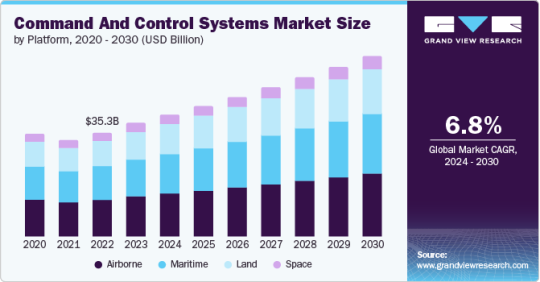
Request a free sample copy or view report summary: Command And Control Systems Market Report
Command And Control Systems Market Report Highlights
Based on platform, the maritime segment is estimated to register the highest CAGR from 2024 to 2030 owing to increasing marine trade, the need for safety and security of shipping operations, and growing investments in naval forces across various countries
Based on solution, the hardware segment accounted for the largest revenue share in 2023 owing to rising demand for robust hardware that enhances the functionality and effectiveness of C2 systems
Based on application, the defense segment dominated the market in 2023 as several governments are aggressively pursuing defense modernization initiatives amid rising security concerns and growing armed conflicts in different parts of the world
In February 2024, Northrop Grumman demonstrated a new software that receives, displays, and shares critical situational awareness data through handheld devices without connecting to a cloud server, protecting warfighters in support of Joint All-Domain Command and Control
Command And Control Systems Market Segmentation
Grand View Research has segmented the global command and control systems market report based on platform, solution, application, and region:
C2 Systems Platform Outlook (Revenue, USD Million, 2018 - 2030)
Land
Maritime
Space
Airborne
C2 Systems Solution Outlook (Revenue, USD Million, 2018 - 2030)
Hardware
Software
Services
C2 Systems Application Outlook (Revenue, USD Million, 2018 - 2030)
Defense
Commercial
C2 Systems Regional Outlook (Revenue, USD Million, 2018 - 2030)
North America
U.S.
Canada
Mexico
Europe
UK
Germany
France
Italy
Spain
Asia Pacific
China
India
Japan
South Korea
Australia
Latin America
Brazil
Middle East & Africa (MEA)
UAE
Saudi Arabia
South Africa
List of Key Players of Command And Control Systems Market
Lockheed Martin Corporation
BAE Systems
Collins Aerospace
Thales Group
Leonardo S.p.A.
Elbit Systems Ltd.
Boeing
Northrop Grumman
Saab
CACI International Inc
Barco NV
Christie Digital Systems USA, Inc.
InFocus Corporation
Activu
Panasonic Corporation
Planar
Datapath Ltd.
Extron Electronics
Matrox
Hiperwall, Inc.
Green Hippo Ltd. (tvOne)
RTX Corporation
tvONE
RGB Spectrum
Userful Corporation
VuWall Technology Inc.
0 notes
Text

This is a Japanese magazine advertisement showing the Yamaha WaveBus, developed in 1994 by Yamaha and unveiled at the 1995 MotorWorld Auto show. Designed to seat 20 passengers, this bus is mainly meant to be used for water-based tours and transportation (to and from private islands, for instance). It has a dual rear-mounted propeller powered by the same kind of engines used on many contemporary Yamaha crafts of the time, and features retractable wheels underneath the vehicle for land use. The vehicle is designed to be able to enter the water right from a launching point or the beach, and can be safely exited and re-entered when stopped, making it useful for swim/snorkel tours. They have also come in handy as a sort of "floating grandstand" for amphibious car races all across Japan. The bus was a wild success, and was used in many resorts across Japan for the next several years, however it never quite broke past the East Asian market. Despite that, in some rare instances you may come across an American or European beach resort which employs the use of this revolutionary vehicle.
2 notes
·
View notes
Text
Commercial Vehicle Accessories Market ruling majority of the Aftermarket Automotive Accessories Market

The Commercial Vehicle Accessories Market is a dominant force within the broader Aftermarket Automotive Accessories Market, driven by the increasing demand for enhanced vehicle functionality, safety and aesthetics. With the rising global fleet of commercial vehicles, particularly in emerging economies, the demand for specialized accessories such as telematics systems, cargo management solutions, lighting and safety features is rising. This market encompasses various products and services, including vehicle tracking systems, custom interiors, performance-enhancing parts and external accessories like mud flaps and roof racks.
The Commercial Vehicle Accessories Market has skyrocketed to a market cap of USD 94.88 Billion last year in 2023. This market is experiencing a CAGR of 6.30% which has driven its potential by the increase in demand for essential accessories such as interior upgrades, safety equipment and technological advancements in commercial vehicles.
Some of the Prominent Companies in the Commercial Vehicle Accessories Market are :-
Robert Bosch - Europe (Germany)
Denso - Asia (Japan)
Magna International - North America (Canada)
ZF Friedrichshafen - Europe (Germany)
Hyundai Mobis - Asia (South Korea)
Aisin Seiki - Asia (Japan)
Faurecia - Europe (France)
Lear - North America (USA)
Valeo - Europe (France)
Thyssenkrupp - Europe (Germany)
BASF - Europe (Germany)
Panasonic Automotive - Asia (Japan)
Gestamp - Europe (Spain)
Commercial Vehicle Accessories Market Segmentation
Product by Type Coverage (Includes Market Size, Products by Segment, its Type and Influence) :-
Driveline & Powertrain
Interiors & Exteriors, Electronics
Bodies & Chassis
Seating
Lighting
Wheel & Tires
Market Application in Commercial Vehicle Accessories Market:-
OEMs
Aftermarket
The Commercial Vehicle Accessories Market is segmented by Type and by Application, actors, stakeholders and the other members associated with the Commercial Vehicle Accessories Marketplace who can benefit from consuming the included content as a useful and powerful resource. The report consists of 162 pages of comprehensive data points that are segregated from different key regions around the world.
When it comes to commercial vehicles, the right accessories can make all the difference. Whether it's boosting performance, enhancing safety, or just making the ride more comfortable, the Commercial Vehicle Accessories Market offers a wide range of products designed to meet the unique needs of different industries.
Applications: OEMs vs. Aftermarket
Let’s start by breaking down where these accessories come from. There are two main sources:
OEMs (Original Equipment Manufacturers): These are the accessories that come directly from the vehicle’s manufacturer. They’re built to fit perfectly and work seamlessly with your vehicle. Think of these as the “official” parts that come pre-installed when you buy a new truck or van.
Aftermarket: This is where things get interesting. The aftermarket offers a huge variety of accessories that you can add or upgrade after you’ve bought your vehicle. Whether you’re looking for a better sound system, stronger tyres, or a high-tech navigation system, the aftermarket has it all. Plus, it often offers more options and better prices than OEMs.
Contact Us :
Report Prime - [email protected]
Browse more reports :
Automotive Heat Shields Market Overview
Automotive Parts Zinc Die Casting Market Growth and Restraints
Automotive Fuse Market Size
Sidewall Hovercraft Market and Military Hovercraft Market
Amphibious Hovercraft Market | Light Hovercraft Market
Automotive Hydraulic Systems Market Cap
Fire Block Foam Market Cap
Boron Phosphide Market Forecast [2023-2030]
Market Research by Report Prime.
#CommercialVehicleAccessoriesMarket #CommercialVehicles #CommercialVehicleAccessoriesMarketSize #CommercialVehicleAccessoriesMarketGrowth #VehicleAccessories #CommercialVehicleAccessoriesTrends #CommercialVehicleAccessoriesMarketOppportunities #OEM #Aftermarket #Denso #RobertBosch #MagnaInternational #Continental #ZFFriedrichshafen #AutomotiveIndustry #AutomobileIndustry #AutomotiveMarket #AutomobileMarket
0 notes
Text
Why the Nissan Navara Single Cab is a Smart Long-Term Investment

The right choice of vehicle can make all the difference in a dynamically changing South African business environment. The Nissan Navara Single Cab has held its ground to stay at the forefront of reliability, efficiency, and versatility. This powerhouse from Nissan South Africa deserves closer study by entrepreneurs and businesses looking to secure a smart long-term investment.
Comfort and Style: Built to Last
The Nissan Navara Single Cab is an amphibious workhorse that does not let down on comfort and style. Sturdy in build, it gives endurance and hence can be relied upon by any person who needs a vehicle that will stand both on time and on terrain. Be it city driving or rough country roads.
Fuel Efficiency: A Companion for Business
Thus, one of the major reasons it makes a wise buy is the fuel economy of the Navara Single Cab. In a country where fuel prices can significantly impact a business's bottom line, Navara's economic engine becomes an ace up its sleeve. This will hence reduce associated operating costs with time, helping the firm allocate its resources properly.
Versatility: Adapting to Business Needs
But what makes it versatile for business is this Nissan Navara Single Cab: it has a full-sized cargo bed that can carry goods, equipment, or materials easily. This means it is suitable for a very broad range of industries—from building and agriculture to delivery and just about anything. Its adaptability ensures that as your business evolves, your Navara can keep pace with changing needs.
Durability: Built for Daily Demands
Another strong point of the Navara Single Cab is its durability. This pickup, made from high-strength steel and tested to the extreme, has been reinforced to handle any daily business demands. This strength not only gives assurance of reliability but also helps raise its resale value, further anchoring its place as a smart long-term investment.
Safety: Protecting Your Investment
Navara Single Cab has also received a lot of emphasis on safety from Nissan South Africa by fitting the car with improved features regarding driver and cargo protection. From the cabin structure to the suite of its electronic safety systems, the Navara gives real peace of mind on each journey. Moreover, a car that is designed and built bearing safety in mind is likely to result in lower insurance premiums and less risk of expensive accidents. This adds significant long-term value to the vehicle.
Maintenance: Cost-Effective Upkeep
The Navara also comes with a reputation for reliability in its maintenance needs. With long service intervals and, at the same time, a good network of Nissan service centers across South Africa, your vehicle will have the required service attention while you save on both effort and money. This easy maintenance is one major reason for the Navara's lower total cost of ownership over its lifetime.
Balancing Performance and Eco-Friendliness
The Nissan Navara Single Cab offers each business sensitive to its ecological footprint the perfect balance between performance and care for the environment. Its lean-burn engine cuts fuel costs with less fuel consumption and lowers emissions, meeting increased corporate sustainability goals without giving up a lot of capability.
A Reliable Partner for Business Success
Purchasing a Nissan Navara Single Cab means much more than buying a vehicle; it is about manning your business with a trustworthy partner for the long term. Its durability, efficiency, versatility, and ability to hold its value truly set this vehicle apart from competitors in a saturated pickup market. The Navara Single Cab is, therefore, very well placed to dominate the class as businesses in South Africa look toward running efficiently and investing wisely for the future.
#nissan#nissan cars#cars#pickup#nissan navara#nissan navara single cab#pickup truck#nissan south africa
0 notes